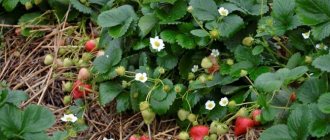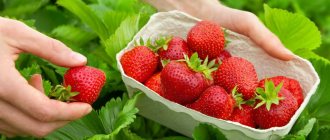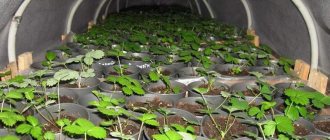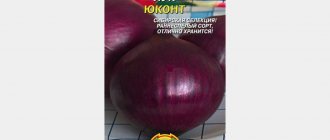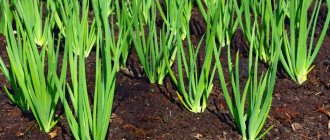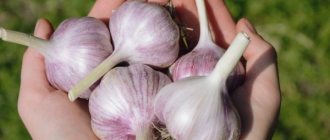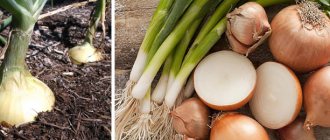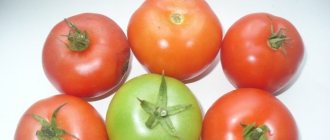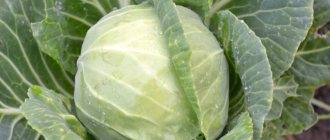Home / Garden / Berries
Back
Published: 07/05/2020
4
Rate this post
The dream of gardeners to receive delicious sweet strawberries all season long has found practical fulfillment. Thanks to the efforts of breeders, a strawberry variety has been developed that bears fruit until autumn. True, you need to know the intricacies of agricultural technology for growing it, since only proper care will allow you to get a high yield.
- 1 Features of culture
- 2 Growing methods
- 3 Agricultural technology in open ground 3.1 Selection and preparation of beds
- 3.2 Planting seedlings
- 3.3 Rules of care
Features of remontant strawberries
Remontant strawberries differ from ordinary strawberries in the time of fruit bud formation. In ordinary strawberries, fruit buds are formed during short daylight hours, and in remontant strawberries, during neutral or long ones. Therefore, remontant varieties, when grown in open ground, bear fruit twice a season: the first time in July, and the second time at the end of August/beginning of September.
The second harvest may be much larger than the first. It can even account for up to 90% of the total number of berries per bush per season, although most often this figure approaches the 60% mark.
Remontant varieties are large-fruited. The weight of 1 berry in some cases can even reach 100 grams. On average, the weight of 1 berry varies from 20 to 75 grams, depending on the variety.
In the absence of special care, already in the second year of growth of the bush, the berries are small and sparse, and in the third year the plant most often dies.
Why doesn't it bloom or bear fruit?
But what if the strawberries don’t bear fruit? These may be the following reasons:
- Degeneration of plants . After a maximum of 3 years, the plants stop blooming. This leads to the need to renew the bushes every 2 - 3 years.
- Too late replanting in open ground in the fall. This leads to the fact that the plant does not have time to adapt. Next year the flowering will be very weak and the berries will be small;
- Excessive penetration into the ground during planting. This leads to a sharp decrease in the number of berries;
- Lack of nitrogenous compounds. Leads to weakening of leaves. Effective prevention in this case is regular watering with an aqueous solution of ammonia;
- Lack of sunlight. This leads to weakening of the bushes, which means a decrease in yield.
Another common reason is late frosts in May. To avoid this trouble, you need to cover the beds with film or spunbond.
Soil preparation
It is better to grow these varieties of strawberries in the area where crops such as carrots, parsley, garlic, radishes, beets or legumes previously grew. At the same time, it is not recommended to plant this crop after potatoes or cucumbers (as well as after tomatoes and cabbage). In addition, it is better not to grow this plant next to raspberries.
The area chosen for planting should be in direct sunlight. In addition, the soil on the site should be level and free of bumps and depressions. Location in lowlands is not allowed.
It is best if the garden bed has sandy or loamy soil. Peat soil, like sod-podzolic soil, is not suitable for growing this crop.
The soil for planting should be either slightly acidic or neutral. It is necessary to prepare the soil for planting in advance. If the crop is planned to be planted in the spring, then preparation is carried out in the fall; if planting will be done in the fall, then the soil is prepared in the spring or summer.
At the beginning of preparation, it is necessary to dig up the ground with a pitchfork and level it with a rake. During digging, it is necessary to remove weed roots and also add fertilizer. As such fertilizers, you can use humus or compost in the amount of 1 bucket per square meter of land. It is also necessary to add 5 kg of wood ash to the soil (the figure is based on 10 square meters).
Once the soil has been fertilized, dug up and leveled, it can be left until planting. A month before the intended planting of the bushes, it is necessary to add potassium sulfate (in the amount of 20 g) to the soil with the addition of superphosphate, which must be taken twice as much as potassium sulfate (the numbers are based on each square meter). After applying the fertilizer, the soil is dug up again.
Soil for remontant garden strawberries
Garden strawberries grow on any soil, but the yield of remontant varieties is higher on light and medium-textured soils with an acidity pH of 5.0–6.5.
Read here how to improve the soil on your site >>>>>
When preparing the soil in the fall, 5–6 kg of organic fertilizers (humus, compost, mature manure) and up to 40 g/m2 of mineral fertilizers are applied per 1 m2. Then a deep excavation of the site is carried out. Planting begins after the prepared soil has settled.
Read about how to choose and buy ready-made seedlings of garden strawberries in this detailed material.
Planting seedlings
With different planting methods, care also differs. The planting time for each type of strawberry may also differ.
Dates and methods of planting
Planting in the ground is carried out in the autumn or in the spring. For the southern regions, it is preferable to plant seedlings in the ground in early September, while for the northern regions it is preferable to plant seedlings in the spring months, but not earlier than May.
For central Russia, it is preferable to choose the autumn months, from the beginning of August to the end of September, but it is also possible in the beginning of spring - from the end of March to mid-April.
You should focus on the temperature regime: the optimal air temperature when planting seedlings is 15-25 degrees Celsius.
Methods of planting seedlings in the ground
- carpet;
- nesting;
- private.
With the nesting method, the distance between plants is set at least half a meter. This method of planting seedlings is suitable for varieties that throw out tendrils. This planting method allows you to get not only a good harvest, but also high-quality planting material.
The advantage of this planting method is that the plants do not come into contact with each other, which means they do not infect each other when diseases occur. In addition, the bushes are well lit, as they do not shade each other.
Among the disadvantages are unused areas of land, of which there are quite a lot with this planting method, since the distance between the bushes is approximately 50 cm.
The distance between strawberry bushes is set at 20 cm - this is with the carpet method. Moreover, 20 cm is not only the distance between the bushes of the 1st row, but also the distance between the rows.
With the row method of planting this crop, a larger distance between the rows is provided - up to 70 cm, while the distance between the bushes remains the same - from 20 to 25 cm. The bushes will grow over time, at the same time the area of the plantation will increase.
Pest and disease control
A long period of fruiting of a crop is a benefit for the gardener, but at the same time it is necessary to take care of protecting plants from diseases and pests. Since chemical treatment is not suitable for fruit-bearing bushes, the first priority is timely prevention.
Recommendations:
- treatment of plantings in early spring and autumn with 2% Bordeaux mixture;
- regular weeding, loosening row spacing (to prevent the appearance of rot);
- spraying the bushes with a soap solution (from ticks, powdery mildew);
- compliance with crop rotation, taking into account the compatibility of garden crops: potatoes, tomatoes, eggplants, and sweet peppers cannot be planted next to strawberry plantations;
- treating bushes with infusion of garlic cloves (from major pests);
- removal of diseased and deformed shoots;
- treating plantings in the fall with a solution of colloidal sulfur (prevents the appearance of strawberry mites);
- dusting the rows with a mixture of mustard powder, ash, hot pepper (from slugs, snails).
The use of such gentle means and methods will protect plantings from diseases and insect attacks, while avoiding the use of toxic chemical compounds.
Methods of growing in open ground
There are many ways to grow this crop. For small summer cottages, non-standard planting methods have been specially developed, which greatly save space on the site.
On the ground in the beds
Among the classic ones, two methods of planting can be distinguished:
- one-liner:
- two-line.
With the one-line method, the distance between the rows is maintained at least 60 cm, and with the two-line method - no more than 30. The one-line planting method is safer for plants, since they do not come into contact with each other and, accordingly, cannot infect each other.
The two-line planting method increases yields because the soil is used more efficiently.
For small areas, there are other ways to plant remontant strawberries in open ground, for example, the vertical method or “in bags.”
Vertical method
With the vertical method, strawberries are planted in pots, cut pipes, tires, boxes or any other containers that can be placed vertically. At the same time, space is greatly saved, since pots with bushes can be placed vertically on several floors. But in this case, care becomes a little more complicated.
"In bags"
When planting in bags, plastic bags are used in which soil is placed, and seedlings are planted in it. Such bags are hung vertically, which also saves space. Holes are made for plants.
Under covering material
Planting a bush of this crop under covering material makes caring for the plant much easier. Growing strawberries in this way allows you to create a microclimate in which the soil does not dry out, but at the same time, due to the lack of sunlight, weeds do not grow under the agrofibre.
In addition, due to the constant humidity under the covering material, earthworms begin to actively live and loosen the soil, so caring for strawberries planted in this way is much simpler.
The berries do not come into direct contact with the soil and this has a beneficial effect on the quality of the product. Therefore, growing remontant strawberries under covering material is a fairly progressive way to get high yields at fairly low costs.
Landing
For planting strawberries, choose sunny places without close groundwater. The soil on the site should be light, fertile with neutral acidity. This will help to achieve good development of the root system, and therefore high yields.
The bed for spring planting of strawberries is prepared in mid-April. To do this, dig up the soil to the depth of a spade bayonet. Mineral fertilizers are applied during digging: superphosphate and potassium salt. Their consumption rates are indicated on the packaging.
When planting, the distance between bushes should be at least 20-40 cm, between rows 50-60 cm. When planting in a garden bed, the seedlings are buried to the level of the root collar. You can't plant any deeper. Subsequently, such plants will rot and die.
There are also other landing methods. For example, the soil surface is covered with black agrofibre. The seedlings are planted in pre-drilled holes. The advantage of this method is that seedlings planted on agrofibre do not require weeding, and ripening berries are practically not affected by fruit rot.
Advice! Planting remontant strawberries is possible in the fall. The main thing is that it has time to take root before the onset of frost.
Caring for remontant strawberries during the active growing season
The number of bushes, the quality of the root system and, as a result, the number and size of berries collected from one bush per season depend on the quality and correct care of the plant.
Watering and fertilizing
During the growing season, sufficient attention should be paid to soil moisture. If there is a lack of moisture in the soil, insufficient formation of the ovary or the formation of fruits of irregular shape may occur. All this has a detrimental effect on the quantity and quality of the harvest. Therefore, watering should be regular.
Mulching open areas of land around bushes will help reduce the costs associated with regular soil irrigation. This will lead to moisture retention in the soil, which in turn will allow the plantation to be watered less frequently.
In spring it is necessary to fertilize the soil. For this purpose, ammonium nitrate and potassium sulfate are used. Their quantity is calculated based on the formula: 15 g of substance per 1 square meter of soil.
This calculation is correct for both types of fertilizers. Superphosphate is also used for feeding. Per square meter it is needed twice as much as potassium sulfate.
Pruning remontant strawberries
During the growing season it is necessary to trim the mustache. This should be done throughout the spring and summer period. If you plan to grow new shoots, then the mustaches are not cut, but dug in, and thus by August there will already be young bushes that are ready for replanting. In autumn, pruning of leaves and tendrils is carried out.
All red, blackened, dried or infected shoots are removed. In this way, the bush prepares for wintering in order to more easily endure the winter cold.
What and how affects the quality of the crop
The quality and quantity of the harvest is affected by proper care of bushes and young shoots. The amount of harvest is greatly influenced by the regularity of watering and the absence of pests and diseases in the plant. In addition, the benefits of regular feeding should not be underestimated. During the growing season, fertilizing can be done twice a month.
Also, the correct trimming of the mustache has a great influence on the quality of the harvest. Because young shoots require a lot of effort to take root.
In the absence of proper care for the bushes, the strawberries will be few and small.
Care
To better understand how to properly care for remontant strawberries, it is necessary to take into account the peculiarities of their development. Unlike single-fruiting varieties, remontant varieties experience greater stress. Therefore, they definitely require appropriate feeding and timely watering.
Watering
Strawberry is a moisture-loving plant. It should be watered regularly throughout the growing season. This is explained by the superficial root system of the plant, which is damaged when the surface layer of soil dries out. The frequency of watering strawberries depends on weather conditions:
- in spring and early summer, before the onset of stable heat, the plants are watered weekly;
- When the temperature rises significantly, watering is carried out 2-3 times a week; it is necessary to monitor the humidity level.
Attention! Flood is no less harmful to strawberries than drought. Excess moisture very often causes the development of various rots.
With sufficient watering, strawberry rosettes quickly grow leaf mass and lay a large number of flower buds. With a lack of moisture, metabolic processes are inhibited, and the plants themselves look depressed.
Watering is best done in the morning or evening. It is advisable that the irrigation water be warm. Strawberry bushes are watered strictly at the root. To reduce labor costs, you can install drip irrigation on strawberry beds.
Top dressing
When caring for strawberries, timely application of fertilizers is mandatory. The best option is to alternate organic matter with mineral fertilizers.
The timing of fertilizer application for remontant varieties is as follows:
- Immediately after the snow melts, the bushes are fed with a urea solution.
- After 2 weeks, phosphorus-potassium fertilizers are used. They promote the formation of flower buds.
- After harvesting, remontant strawberries are fed with a fermented mullein solution.
- In early August, phosphorus-potassium fertilizers are reused.
Attention! Fertilizers should not be applied in the fall. Strawberries that have begun to grow overwinter very poorly.
Mustache trimming
After planting, caring for strawberries also involves trimming the mustache. The peak of their growth occurs in the second half of summer. The mustache develops from dormant buds located at the bottom of the bush. As they grow, the rows thicken and the yield decreases significantly.
Mustaches should be trimmed as they grow. Usually they are removed 2-3 times during the summer. For pruning, use pruning shears or sharp scissors. Upon completion of work, all plant residues must be removed.
Spring-summer mustaches are often used to propagate the best remontant varieties. They perfectly convey varietal characteristics. With their help, you can quickly obtain a fairly large amount of high-quality planting material.
Features of autumn care
When growing remontant varieties with long daylight hours, the crop sometimes does not have time to ripen completely. With the onset of early frosts, the bushes do not have time to adapt to them and die. Therefore, in the fall, when caring for remontant strawberries, it is necessary to create protective shelters. For example, bushes can be covered with pine spruce branches, a layer of straw or a special perforated film. They will protect the bushes from freezing.
When caring for strawberries, you should pay attention to the prevention of diseases and pests. To do this, before the onset of stable frosts, all leaves are cut off from the bushes. After which I treat the strawberry bed with a fungicide solution. For example, you can use Bordeaux mixture. After completion of work, all plant residues must be destroyed. If this is not done, they can become a breeding ground for pests and diseases.
Propagation of remontant strawberries
Propagation of remontant strawberry varieties is carried out in at least three ways:
- growing from seeds;
- by dividing the bush;
- and with the help of a mustache.
Growing seedlings from seeds
When growing strawberries from seeds, the purest varieties are obtained. This planting method is very labor-intensive, since it is carried out in the spring and lasts for several months.
Seeds must be prepared in advance. Preparations must begin as early as February, and only in mid-May will the seedlings be ready and need to be planted in the beds.
Dividing the bush
The method of propagating remontant strawberries by dividing the bush is resorted to in case of an insufficient number of seedlings or when it is necessary to quickly move part of the plantation to another place. To grow strawberries using this method, you need strong and healthy plants. Therefore, they choose either two-year-old or four-year-old bushes. Their root system should be strong and healthy.
At 4 years of age, the bush has several dozen shoots of horns. Each horn is already well developed, has lateral buds and formed leaves. In addition, it has well-developed adventitious roots. Such plants can be planted only in spring, or in emergency cases - in early autumn. Having dug such bushes from the ground, they must be divided and planted immediately.
After transplanting, it is necessary to water the plants daily. If it is scorching hot outside at this time, it is necessary to provide the young seedlings with constant shade.
Reproduction by mustache
Propagation by mustache is an economical method that is the easiest in terms of labor costs. In addition, new bushes obtained in this way give a harvest next year.
However, when propagating strawberries using this method, it is necessary to sacrifice the second harvest of the season. The fact is that the strawberry bush spends energy either on the formation of berries, or on the development and rooting of the mustache. Therefore, if you want to obtain high-quality planting material, you must refuse to obtain a second harvest.
For propagation in this way, annual bushes are selected that, at the first fruiting, produced large, even berries. The first tendrils that appear must be spread around the bush, giving them the opportunity to take root. Whiskers that appear later must simply be removed.
By August the young bushes will be ready. A week before moving them to a new place, it is necessary to trim the mustache that connects them to the mother bush. Young bushes are transplanted to a new location using a small spatula.
It is advisable to move the bushes with a small lump of earth, this way the root system will suffer less and the plant will more easily tolerate replanting.
Secrets of growing delicious strawberries
In order for growing strawberries to be a pleasure, the harvest to be high and tasty, it is worth knowing some subtleties. Below are a few secrets that can help you achieve success.
- Purchasing certified virus-free strawberry seedlings. Healthy plants are the key to successful strawberry growing.
- Predecessors. Avoid planting strawberries in areas where potatoes, tomatoes and strawberries have recently been grown.
- You need to provide plenty of sunlight. Find a sunny place. Heat and light help produce sweet and tasty berries.
- Fertile and permeable soil. It is better to plant strawberries in slightly acidic soil 6 -6.5 pH. About a month before planting, mix the soil with compost or manure. Pelleted manure (easy to use, natural, safe and odorless) is also a great solution.
- Agrotextiles against weeds. Don't let weeds compete with your strawberries. Black agrotextiles naturally prevent the development of weeds, while simultaneously allowing water and air to pass through, retaining moisture in the soil. Strengthens the root system and speeds up the growing season. An additional advantage of using agrotextiles is the collection of clean and unsorted berries. It is worth additionally during the flowering season to spread straw under the plant, which will reflect the sun's rays and the fruits will not ripen so quickly.
- Space. Plant the seedlings at a distance of about 30 centimeters, the distance between rows is 50 centimeters. Strawberry roots should not curl. Be careful not to plant the strawberries too shallow so the roots dry out or too deep.
- Pick ripe berries on a sunny day. To keep strawberries fresh and firm longer, pick the fruit together with a stem at least 1 cm long.
- Replace old plants every 3-4 years. Strawberries will become unproductive after this time. It is best to replace them with new ones that are free from disease and pests.
When growing strawberries with repeated fruiting, it is imperative to take into account the peculiarities of its development, and the plants must be properly cared for. You can hope to obtain high yields only if these conditions are met.
Autumn preparation for winter
Autumn preparation involves removing everything that could prevent the bush from overwintering normally and bearing fruit with renewed vigor starting in the new season. This means removing any runners that have not taken root, as well as any damaged, reddened or weak leaves.
In addition, in harsh winters, any strawberries must be covered. It is better to choose a material whose density is about 60 grams per square meter. Agrofibre, spunbond or any other material is suitable for these purposes.
Mulch, pine needles, leaves or grass are also used to cover strawberries. Although this method appears to be more economical than purchasing fiber, there are a number of disadvantages to using it. In this case, mice may appear in the shelter, which are enemies of strawberries. They damage shoots and dig tunnels.
When covering a strawberry plantation, it is better to opt for special covering materials or thick plastic film.
How is it different from other varieties?
Regular strawberries require less care and preparation before wintering. However, if a remontant variety is used, then it is important to properly prepare the plant for the cold. If the strawberries do not gain strength, then the harvest will be very small.
If in the first season the planting material was not nutritious enough, then it is recommended not to allow such strawberries to bloom. It is necessary to pluck out the flower stalks even before the bush begins to gain strength and grow.
Only well-developed bushes that have formed correctly can bear fruit. Next year, such a plantation will bring a new harvest if the first ovaries are left to bear fruit.
Also, unlike other varieties of strawberries, remontant plants need more frequent renewal, since the berries quickly consume soil resources. Therefore, you cannot grow such strawberries in the same place for too long.
Next year, it is necessary to prepare new beds at the end of summer, immediately after garlic, onions and other early crops.
In the first half of the season, it is necessary to remove strawberry tendrils (if the variety suggests their presence). Only in this case will the plant begin to direct more energy to form fruits. Waiting too long to prune will result in more flowers forming and delaying the fruiting process.
Starting from the middle of the season, you need to cut off excess leaves. It is also necessary to constantly get rid of old and dried foliage. To ensure a supply of planting material, it is enough to leave mustaches on just a few bushes.
Remontant strawberries, the best varieties of which produce a large amount of harvest, differ from the classic plant not only in the amount of fruiting, but also in the speed of growth. Therefore, leaves and tendrils appear much more often for removal. This also means that the plant needs to be weeded and fertilized more often so that the strawberries can quickly gain strength for the next cycle.
In ordinary strawberries, the first flowers are not removed, but for remontant varieties this is an important condition. In some situations, it is necessary to cut off subsequent inflorescences. It depends on the condition of the plant. Sometimes it is better to get 2 full-fledged harvests than 3 rather weak ones.
Varieties of remontant strawberries
There are several dozen varieties of remontant strawberries. Only a few of them will be described below.
Autumn fun
This variety was popular back in Soviet times; it was one of the first to be included in the Soviet DSD selection. The bush of this variety bears fruit twice a season, with proper care. The berries are small in size, their weight most often does not exceed 20 g. The taste of the berries is quite sweet; the fruits of this variety of strawberries are used to create all kinds of desserts. The pulp of this species is quite dense, so they are often used for freezing.
This variety is propagated with the help of mustaches, of which the bush produces a lot during the season. The variety is also resistant to attacks by fungal infections and strawberry mites.
Russian size
This variety is distinguished by large fruits. Moreover, it is frost-resistant and therefore suitable for cultivation in more northern regions. The berries are very juicy, the plants are resistant to diseases.
Galya Chiv
A fairly new hybrid variety, bred in Italy, which is characterized by high productivity. The average weight of one berry is about 45 g. The color of the berries is bright red, in addition, they are distinguished by their high sugar content.
Vima Rina
This is a Dutch variety; it lays fruit buds during neutral daylight hours. Vima Rina practically does not produce antennae, so it is propagated in other ways. This variety bears fruit starting from the second half of June and continues until the first frost.
The color of Vima Rin's berries is deep red, darker than those of other varieties. The fruits are large, weighing up to 75 g. The taste of this strawberry is sweet and soft, and the density of the berries is low (they are not suitable for freezing).
Diamond
Diamond is an American variety. At the moment it is considered the best among all varieties of remontant strawberries.
This species is propagated using a mustache.
Selva
This variety is one of the best. Firstly, it is very highly productive, and secondly, it has excellent taste. Large fruits, reaching 50 g, are dark red in color, and have light flesh inside.
Queen Elizabeth 2
For Queen Elizabeth II, the weight of 1 berry can reach record figures of up to 110 grams. This is a very frost-resistant variety and produces its first fruits quite early.
Novel
This hybrid variety has pink flowers. This feature makes it easy to distinguish Roman from other types of remontant strawberries.
This variety can be grown in protected soil. With proper care, it can bear fruit for up to 10 months a year. The berries are not large - up to 25 grams.
Lyubasha
Lyubasha is unpretentious, frost-resistant, has small, dark red fruits. Most often it is used for vertical cultivation, since the berries are formed not only on bushes, but also on rosettes.
The best varieties that repeat fruiting
All varieties of re-fruiting strawberries produce a harvest at least 2 times during the growing season. There are also varieties in which flowering and ripening occur in waves or constantly. It all depends on the temperature regime, soil characteristics, watering, fertilizing, as well as varietal characteristics.
The best varieties for the Moscow region and central Russia:
- Monterey;
- Ruyana;
- San Andreas;
- Portola;
- Temptation;
- Queen Elizabeth II;
- Diamond;
- Moscow delicacy.
For the Krasnodar Territory and southern Russia, the choice of remontant varieties is wide. We need varieties that can tolerate high temperatures well. In protected soil conditions, you can grow remontant strawberries until the New Year:
- Albion;
- Ali Baba;
- Moscow delicacy;
- Monterey;
- San Andreas.
The best varieties for Siberia are early, with a short ripening period. The choice should be based on a combination of early fruiting and increased winter hardiness. In open ground conditions, it is necessary to practice planting on black film in warm beds. The Siberian climate is resisted by:
- Alexandria;
- Mount Everest;
- Rügen;
- Ruyana;
- Rimona;
- Selva;
- Baron Solemacher.
Good remontant varieties for the Urals:
- Brighton;
- Autumn fun;
- Temptation;
- Geneva;
- Lyubava;
- Queen Elizabeth II.
Growing problems and their solutions
The main problem that may arise when growing remontant strawberries is the lack of fruiting. There may be several reasons - disease, aging of the bush, improper care.
Table: solving problems when growing strawberries
| Problem | Cause | Solution |
| Weak flowering, small berries | Bush depletion | Planting a renewed bush in a new place |
| Strawberries planted last year do not bloom in spring | Planting too late in the fall | To get an early harvest, new bushes should be planted no later than the end of July - beginning of August |
| Productive plants have lost their flowering | Insufficient watering and nutrition | Strict adherence to agricultural technology |
| Flowering is normal, but fruiting is absent | Poor pollination due to prolonged rainfall or insecticide use | To attract bees, flowers are sprayed with coriander or anise oil. |
| The center of the flower turns black | Exposure to frost | Cover during frosts with straw mulch or agrofibre |
| The buds dry up and fall off | Impact of the pest - strawberry weevil | Within 5 days after the appearance of signs, the soil around the diseased bush must be loosened and treated with an insecticide (Lepidotsid, Fufanon, Aktellik, for industrial plantations - Karbofos) |
As a preventive measure against fungal diseases and pests, root feeding or spraying the leaves with iodine solution is used. For watering under the root, add 15 drops to 10 liters of water, for spraying - 7 drops of a pharmaceutical preparation. Iodine is a good antiseptic and will prevent rot infection. Fertilizing is carried out after waking up the plants three times with an interval of 10 days.
Fertilizers for plants
To get a good harvest, it is important to fertilize strawberries in a timely manner.
Mineral mixtures
At the beginning of spring, you need to feed the plants with nitrogen, and during the flowering period and after the fruiting cycle you will need potassium. Phosphorus can be carried into the soil during the formation of beds. To do this, you will need superphosphate in the amount of 20 g per 1 m2. At the end of May it is recommended to apply urea. To do this, you need to dissolve 1-2 g of the substance in a bucket of water. This is enough for 1m2.
Organic fertilizers
Such fertilizers are applied during the second fruiting, in June. The optimal fertilizer is mullein diluted with water in a ratio of 1:10. You can also use bird droppings. In this case the ratio is 1:15. Additionally, you can use complex fertilizers.
